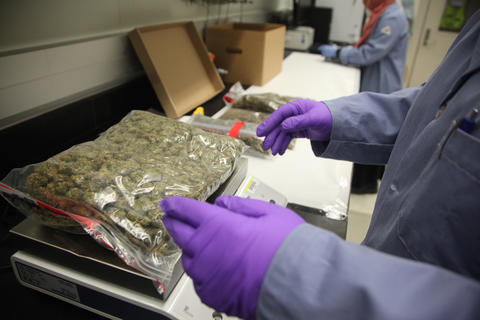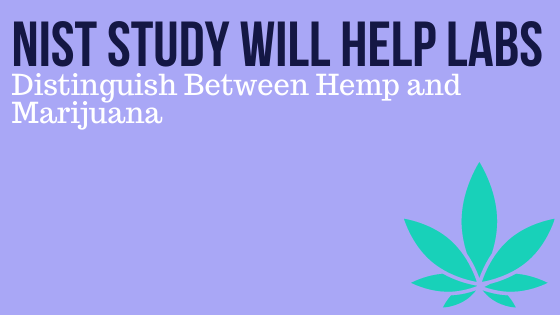Today’s blog is written by guest blogger, Rich Press. Reposted from the NIST blog with permission.
Hemp and marijuana both come from the Cannabis plant. But legally, they are very different. If cannabis has less than 0.3% THC — for tetrahydrocannabinol, the chemical that produces a high — it is considered hemp and legal throughout the United States. Otherwise, it’s marijuana and currently treated as a controlled substance by the federal government and many states.
But labs can have a hard time distinguishing between the two because accurately measuring THC can be difficult, especially at such low levels. Now, the National Institute of Standards and Technology (NIST) is inviting labs to participate in a study that will help them get the accurate measurements they need to make a reliable call.
This study is part of NIST’s Cannabis Quality Assurance Program, or CannaQAP, which helps both forensic and cannabis industry labs accurately measure cannabis compounds. For this study, NIST will send hemp and marijuana plant samples to labs, which will measure the concentration of various compounds and report back to NIST.
This type of interlaboratory study helps labs diagnose technical issues and increases measurement consistency across labs. Labs that are interested in participating can enroll through Feb. 5, 2021.

Many labs have limited experience measuring cannabis compounds. Before the 2018 Farm Bill established the 0.3% threshold, for instance, most crime labs identified marijuana by simply detecting the presence of THC. Today, they need to measure the concentration, and the results of that measurement can have significant consequences.
“If you’re going to confiscate a farmer’s crop, or subject a person to prosecution, you want to be sure that measurement is accurate,” said NIST research chemist Brent Wilson.
Hemp is grown for its fibers, which are used in textiles, paper and other products. Hemp is also grown to produce cannabidiol, or CBD, a nonintoxicating compound that is added to many foods, creams and other products for its purported health benefits.
In addition to THC, the NIST study will help cannabis industry labs accurately measure CBD and several other compounds. This will help hemp growers and cannabis companies know the legal status of their products and properly label them for consumers. The study will also include measurements of arsenic, lead and other agricultural contaminants that producers might measure to ensure product safety.
This study builds on earlier work that had labs measure cannabis compounds in hemp oil. The results of that study, to be published later this year, will show how much measurement results vary across labs.
This new study will be more challenging for labs because it involves plant material rather than oils. Plant-based measurements are more difficult because the compounds are bound up in plant fibers. Lab analysts have to extract the compounds before measuring them, which adds steps and introduces more variability.
For this study, Wilson prepared hemp and marijuana samples with rigorous consistency. Working in the NIST lab, he first ground hemp and marijuana into powders. Then, like a baker sifting flour, he separated the powders by particle size. Finally, he blended the powders into batches and carefully measured how much of each compound and contaminant was present in each batch.
NIST will send samples from those batches to participating labs. All labs will receive legal hemp samples. Labs that are licensed to handle controlled substances can also request marijuana samples.
Labs will then make measurements on those samples and report their results back to NIST, along with information on the methods they used. After the results are in, NIST will reveal the correct numbers so that labs can see how they performed and troubleshoot their methods if needed.
NIST will also publish the labs’ measurement methods and results. That data will be anonymized. Readers will be able to see the amount of variation across labs but not how any specific lab performed.
“Our goal is to provide a learning opportunity for labs, not to publicize their performance,” said NIST research chemist Melissa Phillips, who helped design the study.
Finally, NIST will evaluate which methods produced the most accurate results. Different labs use different methods for preparing and analyzing cannabis, and this will shed light on which methods work best.
After the study is done, NIST will re-run the exercise. “We expect that in the second round, we will see less variability in the lab measurements, as labs overall improve their methods,” Phillips said.
NIST is also working to produce a hemp reference material — that is, a material that comes with a data sheet with accurate measurement values. Labs will be able to use that material to validate their measurement methods. One reason that labs can have a hard time getting accurate measurements in this area is that, currently, there are no widely available reference materials for cannabis.
NIST produces thousands of standard reference materials and has a long history of conducting quality assurance programs like CannaQAP. Past programs have helped labs accurately measure vitamins in foods and dietary supplements, fatty acids in human blood plasma, and environmental contaminants in groundwater.
WOULD YOU LIKE TO SEE MORE ARTICLES LIKE THIS? SUBSCRIBE TO THE ISHI BLOG BELOW!
SUBSCRIBE NOW!


